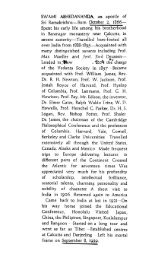<strong>Practical</strong> <strong>Vedanta</strong>names, Prakriti, which is very much the same as the word nature, and the morescientific name, Avyakta, undifferentiated, from which everything proceeds, suchas atoms, molecules, and forces, mind, thought, and intelligence. It is startling tofind that the philosophers and metaphysicians of India stated ages ago that mind ismaterial. What are our present materialists trying to do, but to show that mind is asmuch a product of nature as the body? And so is thought, and, we shall find byand by, intelligence also: all issue from that nature which is called Avyakta, theundifferentiated. The Sankhyas define it as the equilibrium of three forces, one ofwhich is called Sattva, another Rajas, and the third Tamas. Tamas, the lowestforce, is that of attraction; a little higher is Rajas, that of repulsion; and the highestis the balance of these two, Sattva; so that when these two forces, attraction andrepulsion, are held in perfect control by the Sattva there is no creation, nomovement in the world. As soon as this equilibrium is lost, the balance isdisturbed, and one of these forces gets stronger than the other, motion sets in, andcreation begins. This state of things goes on cyclically, periodically. That is to say,there is a period of disturbance of the balance, when forces begin to combine andrecombine, and things project outwards. At the same time, everything has atendency to go back to the primal state of equilibrium, and the time comes whenthat total annihilation of all manifestation is reached. Again, after a period, thewhole thing is disturbed, projected outwards, and again it slowly goes down —like waves. All motion, everything in this universe, can be likened to wavesundergoing successive rise and fall. Some of these philosophers hold that thewhole universe quiets down for a period. Others hold that this quieting downapplies only to systems; that is to say, that while our system here, this solarsystem, will quiet down and go back into the undifferentiated state, millions ofother systems will go the other way, and will project outwards. I should ratherfavour the second opinion, that this quieting down is not simultaneous over thewhole of the universe, and that in different parts different things go on. But theprinciple remains the same, that all we see — that is, nature herself — isprogressing in successive rises and falls. The one stage, falling down, going backto balance, the perfect equilibrium, is called Pralaya, the end of a cycle. Theprojection and the Pralaya of the universe have been compared by theisticalwriters in India to the outbreathing and inbreathing of God; God, as it were,breathes out the universe, and it comes into Him again. When it quiets down, whatbecomes of the universe? It exists, only in finer forms, in the form of cause, as it iscalled in the Sankhya philosophy. It does not get rid of causation, time, and space;they are there, only it comes to very fine and minute forms. Supposing that thiswhole universe begins to shrink, till every one of us becomes just a little molecule,we should not feel the change at all, because everything relating to us would beshrinking at the same time. The whole thing goes down, and again projects out,the cause brings out the effect, and so it goes on.What we call matter in modern times was called by; the ancient psychologistsBhutas, the external elements. There is one element which, according to them, isfile:///C|/Documents%20and%20Settings/Chitra%20Selva...oksBySwami/<strong>Practical</strong><strong>Vedanta</strong>/<strong>Practical</strong><strong>Vedanta</strong>PDF.html (84 of 113)2/26/2007 12:24:34 AM
<strong>Practical</strong> <strong>Vedanta</strong>eternal ; every other element is produced out of this one. It is called Âkâsha. It issomewhat similar to the idea of ether of the moderns, though not exactly similar.Along with this element, there is the primal energy called Prâna. Prana andAkasha combine and recombine and form the elements out of them. Then at theend of the Kalpa; everything subsides, and goes back to Akasha and Prana. Thereis in the Rig-Veda, the oldest human writing in existence, a beautiful passagedescribing creation, and it is most poetical — "When there was neither aught nornaught, when darkness was rolling over darkness, what existed?" and the answeris given, "It then existed without vibration". This Prana existed then, but there wasno motion in it; Ânidavâtam means "existed without vibration". Vibration hadstopped. Then when the Kalpa begins, after an immense interval, the Anidavatam(unvibrating atom) commences to vibrate, and blow after blow is given by Pranato Akasha. The atoms become condensed, and as they are condensed differentelements are formed. We generally find these things very curiously translated;people do not go to the philosophers or the commentators for their translation, andhave not the brains to understand them themselves. A silly man reads three lettersof Sanskrit and translates a whole book. They translate the, elements as air, fire,and so on; if they would go to the commentators, they would find they do notmean air or anything of the sort.The Akasha, acted upon by the repeated blows of Prana, produces Vâyu orvibrations. This Vayu vibrates, and the vibrations growing more and more rapidresult in friction giving rise to heat, Tejas. Then this heat ends in liquefaction,Âpah. Then that liquid becomes solid. We had ether, and motion, then came heat,then it became liquefied, and then it condensed into gross matter; and it goes backin exactly the reverse way. The solid will be liquefied and will then be convertedinto a mass of heat, and that will slowly get back into motion; that motion willstop, and this Kalpa will be destroyed. Then, again it will come back and againdissolve into ether. Prana cannot work alone without the help of Akasha. All thatwe know in the form of motion, vibration, or thought is a modification of thePrana, and everything that we know in the shape of matter, either as form or asresistance, is a modification of the Akasha. The Prana cannot live alone, or actwithout a medium; when it is pure Prana, it has the Akasha itself to live in, andwhen it changes into forces of nature, say gravitation, or centrifugal force, it musthave matter. You have never seen force without matter or matter without force;what we call force and matter are simply the gross manifestations of these samethings, which, when superfine, are called Prana and Akasha. Prana you can call inEnglish life, the vital force; but you must not restrict it to the life of man; at thesame time you must not identify it with Spirit, Atman. So this goes on. Creationcannot have either a beginning or an end; it is an eternal on-going.We shall state another position of these old psychologists, which is that all grossthings are the results of fine ones. Everything that is gross is composed of finethings, which they call the Tanmâtras, the fine particles. I smell a flower. Tosmell, something must come in contact with my nose; the flower is there, but I dofile:///C|/Documents%20and%20Settings/Chitra%20Selva...oksBySwami/<strong>Practical</strong><strong>Vedanta</strong>/<strong>Practical</strong><strong>Vedanta</strong>PDF.html (85 of 113)2/26/2007 12:24:34 AM
- Page 1 and 2:
Practical VedantaPractical VedantaP
- Page 3 and 4:
Practical Vedantaworld. If I am a s
- Page 5 and 6:
Practical Vedantadifference is only
- Page 7 and 8:
Practical VedantaThe ideal of faith
- Page 9 and 10:
Practical Vedantamoment of our live
- Page 11 and 12:
Practical Vedantaof the Christs and
- Page 13 and 14:
Practical Vedanta"This life is Brah
- Page 15 and 16:
Practical Vedantadark fifteen days,
- Page 17 and 18:
Practical Vedantalife. This is the
- Page 19 and 20:
Practical Vedantaeverything would b
- Page 21 and 22:
Practical Vedantait is only through
- Page 23 and 24:
Practical Vedantawhich is that subt
- Page 25 and 26:
Practical Vedantanoumenon and pheno
- Page 27 and 28:
Practical Vedantato which is the be
- Page 29 and 30:
Practical VedantaAbsolute.The finit
- Page 31 and 32:
Practical Vedantawhich is not the q
- Page 33 and 34: Practical Vedantaexperience that th
- Page 35 and 36: Practical Vedantafulfilled. The Jiv
- Page 37 and 38: Practical Vedantabetween the pure r
- Page 39 and 40: Practical Vedantacome out straight.
- Page 41 and 42: Practical Vedantawar with one anoth
- Page 43 and 44: Practical Vedantanobody could under
- Page 45 and 46: Practical VedantaMy idea, therefore
- Page 47 and 48: Practical Vedantathe same methods.
- Page 49 and 50: Practical Vedantavarious minds, all
- Page 51 and 52: Practical Vedantabrotherhood; but t
- Page 53 and 54: Practical Vedantabrotherhood, but w
- Page 55 and 56: Practical Vedantawe all go with ves
- Page 57 and 58: Practical Vedantareason. What can y
- Page 59 and 60: Practical Vedantabeen preached in t
- Page 61 and 62: Practical Vedantathe husband kisses
- Page 63 and 64: Practical Vedantaof the knowledge a
- Page 65 and 66: Practical Vedantafor those who only
- Page 67 and 68: Practical Vedantasun exists because
- Page 69 and 70: Practical Vedantaof death was pleas
- Page 71 and 72: Practical VedantaGod. We must learn
- Page 73 and 74: Practical Vedantaa plague comes, it
- Page 75 and 76: Practical VedantaAtman? "As with a
- Page 77 and 78: Practical Vedantathat immortal One,
- Page 79 and 80: Practical Vedantaand the third egoi
- Page 81 and 82: Practical VedantaWitness of the uni
- Page 83: Practical VedantaPractical Vedanta1
- Page 87 and 88: Practical Vedantafaculty, Buddhi, w
- Page 89 and 90: Practical VedantaPractical Vedanta1
- Page 91 and 92: Practical Vedantastepping-stone to
- Page 93 and 94: Practical Vedantarecognition? Findi
- Page 95 and 96: Practical Vedantasentient." This is
- Page 97 and 98: Practical Vedantaessentially differ
- Page 99 and 100: Practical Vedantaexistence is limit
- Page 101 and 102: Practical Vedantalive, for I am lif
- Page 103 and 104: Practical Vedantasee from Kapila's
- Page 105 and 106: Practical Vedantalimitation, but th
- Page 107 and 108: Practical Vedantaperfect, infinite,
- Page 109 and 110: Practical Vedantaindividuality, of
- Page 111 and 112: Practical Vedantarepeat [something]
- Page 113: Practical Vedantaperson who dies in
















